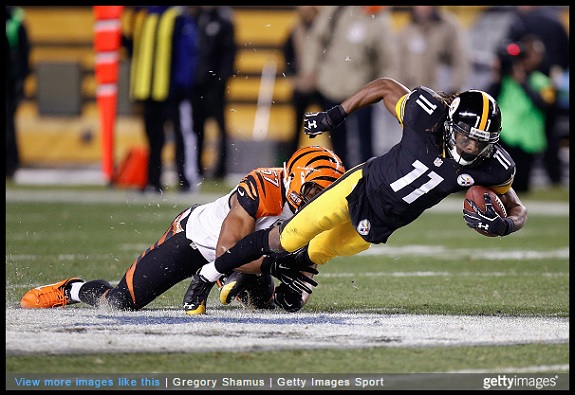During his second season last year, the first in which he got any kind of meaningful playing time, Pittsburgh Steelers wide receiver Markus Wheaton entered the starting lineup, ultimately starting 11 games, catching 53 passes for 644 yards, and adding two touchdowns in the process. He added an additional five receptions for 66 yards in the postseason.
Those are solid figures for a first-year starter when the offense also includes an elite wide receiver and pass-catching running back to go along with a prolific pass-catching tight end. The Steelers were the only team in the league to boast five different players accounting for 500 or more receiving yards.
It seems, however, that Wheaton has been reduced to the backburner, seemingly from about every angle, as his role is widely expected to be more limited in his third season. This has largely to do with the emergence of second-year wide receiver Martavis Bryant, who used his raw speed and 6’4” frame to reel in eight touchdown passes in 10 regular season games.
The speculation, then, is not wholly unjustified, but perhaps it goes a bit too far, as I’ve seen it suggested that Wheaton is even “falling out of favor”, citing the drafting of Sammie Coates as evidence of that.
Wheaton is a 24-year-old emerging player with one year of meaningful experience. He has far from reached his potential in less than 1000 career snaps. While his own successes have been overshadowed by the breakout season for Bryant, I think the most damaging element to his reputation has been the ex post facto narrative that Wheaton was not in sync with Ben Roethlisberger.
That simply is not an accurate portrayal of the ups and downs of his season, and has become a myth of the universal narrative. The truth is that there were significant ebbs and flows in terms of both his role and performance, and it’s time to examine that.
Wheaton was actually very successful, and efficient, to begin his career as a starter. In fact, his first game may have been his best, as he caught six receptions on seven targets for 97 yards, including the final two passes on the final drive that set up the game-winning field goal.
In his first four games, in fact, he caught 19 passes on just 25 targets, a completion percentage of 76 percent. But things started to take a dip the following week after he dropped a pass early on, and was limited to just one reception for 17 yards on two targets. Between Week 5 and Week 11, heading into the Bye week, Wheaton caught just 15 of 36 passes.
There were a variety of reasons for this, and Roethlisberger shares the blame. It’s true that Wheaton and his quarterback struggled to get on the same page at times, and his production took a major dip as a result, even if his two touchdowns came during this span.
Bryant’s emergence, and Wheaton’s transition to an every snap player to one slowly seeing less action, also occurred during this period, and surely affected him mentally, as he seems to be the type of player that can be swayed by doubt. He will have to improve upon that.
But it’s easy to forget that Wheaton began to stabilize as the season progressed, and the week off did him good. Over the last six games, including the postseason, he caught 22 of 27 targets, or over 81 percent. Over the last five games alone, he caught 17 of 18, and twice had five-reception, 66-yard games in that span.
Wheaton started off the year strong and finished strong, with a big dip in the middle that has unfortunately colored the hindsight evaluation of his performance. The team is fortunate to have had Bryant emerge the way he has, but the truth is that his success is his own and should not be seen as a negative commentary on what Wheaton can do.








